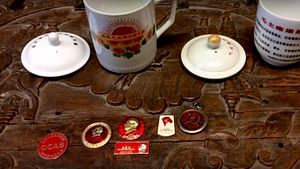When I lived in China in 1985-86, I became obsessed with pencil sharpeners. They came in all shapes: televisions, telephones, and cars; tigers, elephants, and giraffes; pistols, Maotai bottles, and brandy bottles; violins, pianos, and Laughing Buddhas. In one year, I collected over 200 different pencil sharpeners.
The Chinese party-state seems to encourage such obsessions. Its political campaigns from the 1950s to the 1980s produced not only a plethora of slogans, but also a wide range of collectable communist consumer items: Mao badges, propaganda posters, postage stamps, and mugs inscribed with political messages.
To mark the 50th anniversary of the start of China’s Great Proletarian Cultural Revolution (1966-76), this short documentary film explores the everyday experience of revolution and reform by examining these cultural artifacts, and the people who collected them.
To get a sense of the Cultural Revolution’s revolutionary fervor and its Maoist cult of personality, it considers the era’s mass-produced material culture: Mao badges and enamel mugs, both of which were signs of revolutionary modernity.
Starting in 1978, Deng Xiaoping’s economic reform and opening policy offered an alternative development strategy: the China model of authoritarian capitalism. Modernity here switches from revolutionary idealism to the mass consumerism that we see in China today. Maoism thus becomes a consumer activity, as seen in the English-language souvenir version of the “Little Red Book.” The pencil sharpeners mentioned above mirror the consumer dreams promised by Deng’s economic reforms: the “four rounds” (bicycle, wristwatch, sewing machine, and washing machine) and the “three electrics” (television, refrigerator, and telephone), as well as the traditional culture of the Laughing Buddha. (Back in the US in 1986, I noticed that Chinese students were collecting the real things to send home: large fridge-freezers, TVs and computers.)
What do people collect now that urban China is little different from anywhere else? Some circle back to the beginning: the last artifact is a pair of traditional “grass shoes” (caoxie) from a village in the mountains of central China. When bought in 2006, they represented the opposite of the alternative modernities of revolution and reform: as the essence of traditional China, grass shoes are worn by old peasants, and shunned by young people from the city. Although unfashionable, grass shoes are still very practical, and quite comfy for a walk in the hills.
This diverse set of artifacts from the PRC’s recent past gives us a tactile sense of the dramatic changes that Chinese people have experienced over the past 50 years. As chronicled in Tim O’Brien’s iconic Vietnam War novel, The Things They Carried (1990), the things we collect not only tell us about exotic places—they also tell us about ourselves.
“Re-Collecting China” (7 minutes) is based on “An Archeology of Modern China: Artifacts of Revolution and Reform,” an exhibit at the London School of Economics and Political Science, April 2016. For information about this exhibit click here.
Bill Callahan is professor of international relations at the London School of Economics and Political Science, and makes award-winning films including “Toilet Adventures” (2015) and “Mearsheimer vs. Nye on the Rise of China” (2015), which is posted on The Diplomat.

































